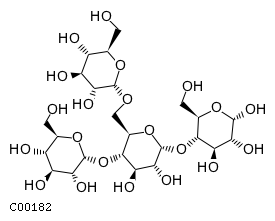
CHEBI:28087
| Name | glycogen |  |
| Synonyms | 0Animal starch; Glycogen; Liver starch; Na; | |
| Definition | A polydisperse, highly branched glucan composed of chains of D-glucopyranose residues in alpha(1->4) glycosidic linkage, joined together by alpha(1->6) glycosidic linkages. A small number of alpha(1->3) glycosidic linkages and some cumulative alpha(1->6) links also may occur. The branches in glycogen typically contain 8 to 12 glucose residues. | |
| Molecular Weight (Exact mass) | 666.5777 (666.2219) | |
| Molecular Formula | C9H13N2O9P | |
| SMILES | OC[C@H]1O[C@H]([C@H](OP(O)(O)=O)[C@@H]1O)n1ccc(=O)[nH]c1=O | |
| InChI | InChI=1S/C9H13N2O9P/c12-3-4-6(14)7(20-21(16,17)18)8(19-4)11-2-1-5(13)10-9(11)15/h1-2,4,6-8,12,14H,3H2,(H,10,13,15)(H2,16,17,18)/t4-,6-,7-,8-/m1/s1 | |
| InChI Key | HQIDPEYTETUCNF-XVFCMESISA-N | |
| Crosslinking annotations | KEGG:C00182 | CAS:9005-79-2 | ChEBI:28087 | NIKKAJI:J98.335G | PubChem:3482 |
| Pathway ID | Pathway Name | Pathway Description (KEGG) |
| map04922 | Glucagon signaling pathway | Glucagon is conventionally regarded as a counterregulatory hormone for insulin and plays a critical anti-hypoglycemic role by maintaining glucose homeostasis in both animals and humans. To increase blood glucose, glucagon promotes hepatic glucose output by increasing glycogenolysis and gluconeogenesis and by decreasing glycogenesis and glycolysis in a concerted fashion via multiple mechanisms. Glucagon also stimulates hepatic mitochondrial beta-oxidation to supply energy for glucose production. Glucagon performs its main effect via activation of adenylate cyclase. The adenylate-cyclase-derived cAMP activates protein kinase A (PKA), which then phosphorylates downstream targets, such as cAMP response element binding protein (CREB) and the bifunctional enzyme 6-phosphofructo-2-kinase/ fructose-2,6-bisphosphatase (one of the isoforms being PFK/FBPase 1, encoded by PFKFB1). |

